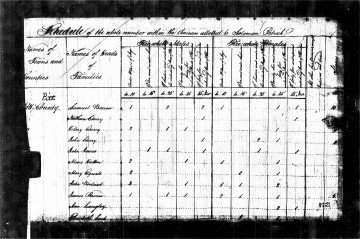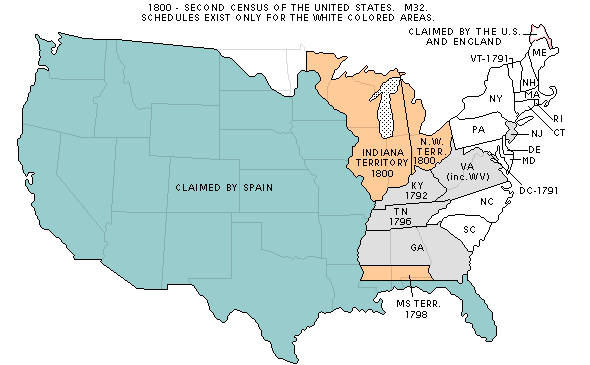The 1800 United States Federal Census contains records for approximately 5 million Americans. The Second United States Census officially began on August 4, 1800 and was taken over a 9-month period of time.
Overview of the 1800 Census
An act of February 28, 1800 authorized the second census of the United States, which was to include the states and territories northwest of the Ohio River and Mississippi Territory. The census was to conclude within nine calendar months of its start.
The guidelines for the 1800 enumeration followed those of the first census, with only minor alterations in the law. John Marshall, secretary of state in 1800, was the nominal head of census operations. By early 1801, however, Marshall was chief justice of the Supreme Court. James Madison, his successor as secretary of state, oversaw the final tabulations and reported population totals to Congress and the president.
The 1800 census contains listings of free white females and males according to age groups. Those groups divided as:
- those under 10 years old
- those between 10 and 16
- those between 16 and 26
- those who were 26 to 45
- those over the age of 45 at the time that the census was taken.
The 1800 census listed each head of household, the number of free persons in the household and the number of slaves in the household. The district and county of residence were also listed along with each household’s information.
1800 Census Facts
- 1800 Census Population: 5,308,483
- 1800 Census Slave Population: 893,602
- 1800 Census Duration: 9 months
- 1800 Census Date: August 4, 1800
- 1800 Census States: 16 States
- 1800 Census Territories: Territory northwest of the Ohio River, Indiana and Mississippi Territory
Questions Asked in the 1800 Census
Some of the questions answered by the census included:
- Name of the head of the family
- Number of free white males
- Under 10 years of age
- Between 10 and 16
- Between 16 and 26, including the head of the family
- Between 26 and 45, including the head of the family
- 45 and upwards, including the head of the family
- Number of free white females
- Under 10 years of age
- Between 10 and 16
- Between 16 and 26, including the head of the family
- Between 26 and 45, including the head of the family
- 45 and upwards, including the head of the family
- Number of other free persons, except Indians, not taxed
- Number of slaves
1800 Census Birth Year Chart
The 1800 Census allowed 9 months to be completed. The first family would have been recorded in August 4, 1800 and the last family on May 4, 1801.
The age groupings were for “For Free White Males and Females.” Numbers shown in the age categories include all persons who were in the home such family, relatives, friends, employees, visitors, and boarders.
No matter when the census taker came, he was to record who was in the house as of August 4, 1800. Age calculated as of August 2, 1790 and does not allow for the 9 month variance.
| FREE WHITE MALES | |
|---|---|
| Age Category | Born Between Years |
| 10 & under (0-9) | 1800-1790 |
| 10 & under 16 (10-15) | 1790-1785 |
| 16 & under 25 (16-18) | 1784-1775 |
| 26 & under 45 (26-44) | 1774-1756 |
| 45 & up (45+) | 1755 and Before |
1800 Census Resources
You may find the following resources helpful in your research of the 1800 census data.
The 1800 United States Federal Census Database at Ancestry.com details those persons enumerated in the 1800 United States Federal Census. In addition, the names of those listed on the population schedule are linked to the actual images of the 1800 Federal Census, copied from the National Archives and Records Administration microfilm, M32, 52 rolls.
Download Free a US 1800 Census Extract Form which allows you to read column headings and record information from the US Census.
Unique Features of the 1800 Census
Native American Population
As in the 1790 census, Native Americans who were not taxed were not listed on the census forms. Because Native Americans were not eligible to hold a seat in the US House of Representatives, their population was not considered relevant to the purpose of the 1800 census.
Inconsistency of Format
As of 1800, there was not a standard form for recording census information. Therefore, records vary widely in format. Some have been re-ordered alphabetically, which hinders the ability to establish who an ancestor’s neighbors were.
Historical Considerations of the 1800 Census
Slave Information
Slaves are listed according to the last names of their owners. This information can be compared to tax list data and probate inventories to determine names and birth orders of family members.
Interesting facts about the 1800 census
- 1800 census was made public, meaning they were posted publicly so those included on the census could , if they could read, view and catch omissions and errors.
- 1800 census did not have pre-printed forms for the census takers to record information. Each census taker was given sample copies and expected copy his census return on whatever paper he could find and post it in two public places.
- Age brackets are slit into five groups, only number of slaves are recorded, and Indians that were not taxed were included.
- The Territory of Louisiana is purchased from France for a cost of 15 million dollars in 1803. The purchase includes all of present day Arkansas, Iowa, Kansas, Missouri, Nebraska, Oklahoma, as well as part of the states of Colorado, Louisiana, Minnesota, Montana, New Mexico, North Dakota, South Dakota, and Wyoming.
- The District of Columbia was founded in 1791 but in the 1800 Census DC’s inhabitants are found under Virginia and Maryland. The Virginia records are lost but the Maryland records are available.
Historical events surrounding the 1800 US Census
- 1800 – John Adams is President during census.
- 1800 – United States Congress holds its first Washington DC Session
- April 24, 1800 – Library of Congress is established.
- 1801 – Thomas Jefferson defeated John Adams.
- November 16, 1801 – The first edition of the New York Post is published.
- May 14, 1804 – Lewis & Clark begin their expedition into the newly acquired Louisiana Territory.
States Covered in the 1800 Census
The 1800 Census recorded information from states and territories in the United States. The new states of Kentucky and Tennessee were included, as well as the Northwest Territory and territories of Indiana and Mississippi.
Although the District of Columbia had already been formed, it did not have a separate census. Residents were either recorded as part of the Maryland or Virginia statistics.
There are 12 States with surviving censuses, they are Connecticut, Delaware, Maine, Maryland, Massachusetts, New Hampshire, New York, North Carolina, Pennsylvania, Rhode Island, South Carolina, Vermont.
What was lost from the 1800 U.S. Census?
Original records of the 1800 census from Georgia, Kentucky, New Jersey, Tennessee, Virginia were lost as well as records from Indiana, Mississippi and Northwest Territories (Only Washington County records from the Northwest territory survive).
Although the original data is lost, there are ongoing efforts to reproduce the 1800 Census for the missing states by using local county records such as tax lists, oaths of allegiance, land entities, militia lists, petitions, road records, and other sources. These types of records are also known as census substitutes.


